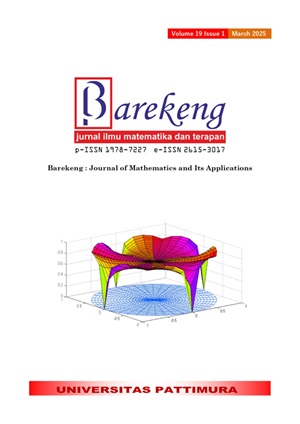ETHNOMATHEMATICAL EXPLORATION OF THE TRADITIONAL FABRIC OF KARAWO GORONTALO IN RELATION TO THE CONCEPT OF TRANSFORMATION GEOMETRY
Abstract
This study aims to explore the ethnomathematics contained in the traditional fabric motifs of Karawo Gorontalo in relation to the concept of geometry transformation. This research is qualitative in ethnographic design. The subjects of this study were Karawo embroidery craftsmen with research locations in Karawo production houses, Ayula village, Tapa district, Bone Bolango regency, Gorontalo Province. Data collection techniques with observation, interviews, documentation studies, and literature studies are then analyzed using Spradley’s domain analysis method. The results showed that is an embroidery art that has been preserved since 1600 AD and continues to be preserved by Gorontalo women until now. Karawo also has a manufacturing process that includes slicing and plucking yarn, Mo-Karawo or embroidery, and the last stage is to make refinement. The Ethnomathematics of Karawo fabric embroidery patterns is the geometry of transformation, which is some motifs that can apply the concepts of translation, reflection, dilation, and rotation. This application shows a relationship and can explain the relationship between the concept of transformation geometry and Karawo and can also be illustrated in the Cartesian diagram.
Downloads
References
M. T. S. Wondo, Maria Fatima Mei, and Finsensius Y. Naja, “Ethnomathematic Exploration of Lio Traditional House of Ende District for Geometry Learning,” J. Pendidik. dan Kebud. Missio, vol. 12, no. 1, pp. 32–44, 2020, doi: 10.36928/jpkm.v12i1.71.
Y. d’Entremont, “Linking Mathematics, Culture and Community,” Procedia - Soc. Behav. Sci., vol. 174, no. 1999, pp. 2818–2824, 2015, doi: 10.1016/j.sbspro.2015.01.973.
K. Reusser and R. Stebler, “Solution-the Social Rationality of Mathematical Modeling in Schools,” Learn. Instr., vol. 7, no. 4, pp. 309–327, 1997.
K. GÜNAY and M. TAKUNYACI, “Examining the Effect of Teaching with Ethnomathematics on Students’ Problem-Solving Skills on Transformation Geometry,” J. Interdiscip. Educ. Theory Pract., vol. 5, no. 2, pp. 86–106, 2023, doi: 10.47157/jietp.1384160.
Sudirman, Rosyadi, and W. D. Lestari, “Penggunaan Etnomatematika Pada Karya Seni Batik Indramayu Dalam Pembelajaran Geometri Transformasi,” Pedagogy, vol. 2, no. 1, pp. 74–85, 2017, [Online]. Available: http://journal.uncp.ac.id/index.php/Pedagogy/article/view/662
A. Bishop, “Cultural Conflicts in Mathematics Education: Developing a Research Agenda.,” Learn. Math., vol. 14, no. 2, pp. 15–18, 1994.
T. Laurens, “Analisis Etnomatematika Dan Penerapannya Dalam Meningkatkan Kualitas Pembelajaran,” J. LEMMA, vol. 3, no. 1, pp. 86–96, 2017, doi: 10.22202/jl.2016.v1i3.1120.
M. Rosa and D. C. Orey, “Ethnomathematics: The Cultural Aspects Of Mathematics Etnomatemática: Os Aspectos Culturais Da Matemática,” Rev. Latinoam. Etnomatemática, vol. 4, no. 2, pp. 32–54, 2011, [Online]. Available: http://www.redalyc.org/articulo.oa?id=274019437002
H. Hodiyanto et al., “Ethnomathematics in Wedding Traditions of Dayak Ethnic,” Proc. Eighth Southeast Asia Des. Res. Second Sci. Technol. Educ. Arts, Cult. Humanit. Int. Conf. (SEADR-STEACH 2021), vol. 627, pp. 229–236, 2022, doi: 10.2991/assehr.k.211229.036.
C. Ditasona, “Ethnomathematics Exploration of the Toba Community: Elements of Geometry Transformation Contained in Gorga (Ornament on Bataks House),” IOP Conf. Ser. Mater. Sci. Eng., vol. 335, no. 1, 2018, doi: 10.1088/1757-899X/335/1/012042.
Sacardi and K. Kett, “A Marchetaria e as Dimensões da Etnomatemática,” 2006.
M. Rosa, L. Shirley, M. E. Gavarrete, and W. V. Alangui, Ethnomathematics and its diverse approaches for mathematics education. Gewerbestrasse 11, 6330 Cham, Switzerland: Springer International Publishing AG, 2017.
K. Massarwe, I. Verner, and D. Bshouty, “Ethnomathematics and Multi-Cultural Education: Analysis and Construction of Geometric Ornaments Journal of Mathematics and Culture,” J. Chem. Inf. Model., vol. 53, no. 9, pp. 1689–1699, 2013.
L. Yahya, N. Nurwan, and R. Resmawan, “Menentukan Waktu Optimal untuk Pembuatan Kerajinan Sulaman Karawo Menggunakan Aljabar Max-Plus,” Vygotsky, vol. 4, no. 1, p. 23, 2022, doi: 10.30736/voj.v4i1.442.
R. L. Syahrial, “Pembentukan Pola Desain Motif Karawo Gorontalo Menggunakan K-Means Color Quantization Dan Structured Forest Edge Detection,” J. Teknol. Inf. dan Ilmu Komput., vol. Vol. 8, no. February, 2021, doi: 10.25126/jtiik.202184491.
K. L. Hada, F. I. Maulida, A. S. Dewi, C. K. Dewanti, and A. M. Surur, “Pengembangan Media Pembelajaran Blabak Trarerodi pada Materi Geometri Transformasi : Tahap Expert Review,” Pendidik. Mat., vol. Vol 4, pp. 155–178, 2021.
J. Soebagyo and A. Noer, “Eksplorasi etnomatematika pada bangunan gapura pramuka,” Euclid, vol. 10, no. 2, pp. 268–280, 2022.
W. P. Rumambie and Y. A. Djalari, “Function of Motives in Karawo Gorontalo Embroidery Fabric,” ARTIc, vol. 4, no. c, pp. 361–372, 2021.
Maryuni, K. Yahiji, and S. D. Yusuf, “Pengembangan Seni Karawo dalam Meningkatkan Perekonomian Masyarakat Gorontalo,” Al-Buhuts, vol. 17, no. 1, pp. 65–74, 2021, doi: 10.30603/ab.v17i1.2219.
Copyright (c) 2025 Putri Ekawaty Kobandaha, Ilham Arief, Nur Fadillah Ibrahim, Wikan Tiyasning A

This work is licensed under a Creative Commons Attribution-ShareAlike 4.0 International License.
Authors who publish with this Journal agree to the following terms:
- Author retain copyright and grant the journal right of first publication with the work simultaneously licensed under a creative commons attribution license that allow others to share the work within an acknowledgement of the work’s authorship and initial publication of this journal.
- Authors are able to enter into separate, additional contractual arrangement for the non-exclusive distribution of the journal’s published version of the work (e.g. acknowledgement of its initial publication in this journal).
- Authors are permitted and encouraged to post their work online (e.g. in institutional repositories or on their websites) prior to and during the submission process, as it can lead to productive exchanges, as well as earlier and greater citation of published works.






1.gif)



